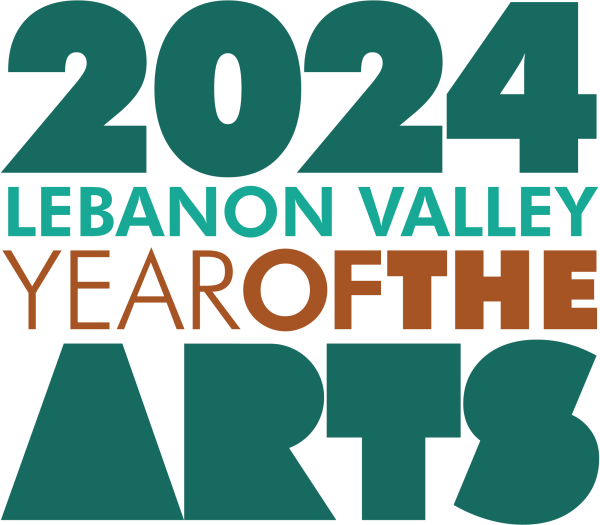The Early Days of the Mount Gretna Outdoor Art Show
with Bruce Johnson
For the past eight months, we’ve been celebrating our Year of Arts by featuring all different types of arts organizations, from theatres and fine art galleries to local artists and art installations. This month, that yearlong celebration is coming to a crest with the 50th Mount Gretna Outdoor Art Show! As the inspiration behind the Year of the Arts and one of Sunshine Artist’s Top 200 art shows, the art show is heralded as a hallmark event for the small town of Mount Gretna each year.
So, much like any other 50th birthday celebration, we decided to look back at the early years of the art show and how it has grown throughout the decades. In doing so, we had the honor to speak to one of the founders of the art show, and a professional artist himself, Bruce Johnson. Taking us right back to 1975, Johnson generously shared a humor-filled recollection of the show’s early years and how an idea over drinks on New Year’s Day has become the show we’re celebrating today…
![]()
“Sounds like a great idea, let’s do it”
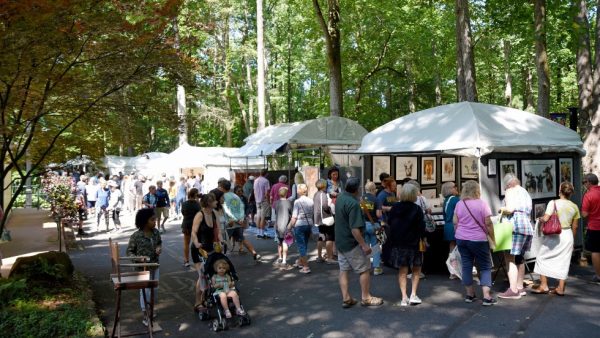
Unlike the snow fencing used in the early days of the art show, tents are used for most artists’ exhibit today. Photo credit: Shannon Fretz, 2023.
It was the early hours of New Year’s Day in 1975 when Bruce Johnson and Reed Dixon planted the seed for an art show in Mount Gretna. In the dining room of a Gretna cottage where their New Year’s Eve parties had converged, Johnson and Dixon chatted about the many outdoor art shows that they had attended.
In that dining room with them was John Wenzler, then chair of the PA Chautauqua, the group overseeing much of the programming in Gretna. As Johnson and Dixon proposed the idea of an outdoor art show in Mount Gretna, Johnson remembers the response of Wenzler, “sounds like a great idea, let’s do it.” Just months later, the inaugural Mount Gretna Outdoor Art Show was held.
“Mount Gretna’s Woodstock”
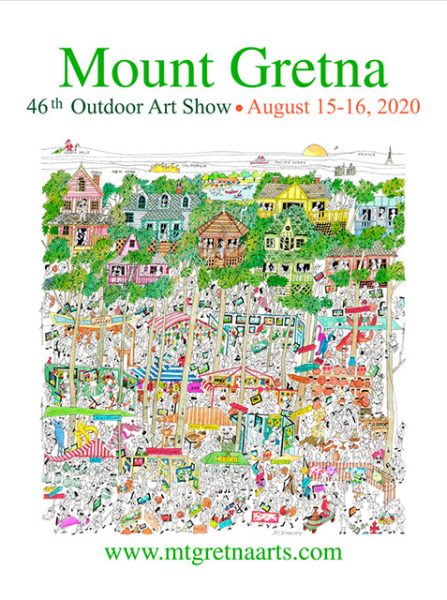
The 2020 art show poster, designed by Bruce Johnson.
Deeming it “Mount Gretna’s Woodstock,” Johnson recalls the anticipation that they felt before the show, stating, “The funny thing is that no one knew what was going to happen. We [Reed and Bruce] knew what an outdoor art show was, but no one else knew.”
With art displayed on snow fencing that was borrowed from the state, the first art show brought together around a hundred artists, including work from both Johnson and Dixon. And much like the three hundred plus volunteers that help at the show today, Johnson, Dixon, and Wenzler garnered help from around the Gretna community. “We had a lot of great friends, and a lot of people did a lot of work for this show,” says Johnson. “Everybody had a job to do, and that’s one of the things that made it so much fun.”
Although they had worried that the Gretna residents would not “like all the people invading their space,” Johnson found that most welcomed the excitement of watching the show from their porches. Some residents, like himself, even took to hosting artists in their homes, “We had 30 people at our house—some even on our porch in sleeping bags—they were absolutely everywhere,” says Johnson.
In discussing that first year, Johnson admits that there was one bad thing that happened. Perhaps unsurprising for many who frequent Mount Gretna, that “bad thing” was parking related. “A police chief was called,” says Johnson. “Reed and I worked very hard to get people to the show and he went berserk ticketing cars because there were people parked where they shouldn’t be. We were very upset with him because he probably handed out about 100 tickets.”
Though surely not the best for their marketing, the ticketing didn’t hinder the art show from a successful return the following year. Not only that, but they even brought in support from nearby Fort Indiantown Gap National Guard Training Center, thanks to a connection through John Wenzler, “John was so important because he knew everyone,” says Johnson. “His son-in-law was a military police at Indiantown Gap, so he brought the MP’s down and they became the traffic directors and guarded the displays at night. They even turned it into an army exercise.”
“From the inside out, it was an awful lot of fun”
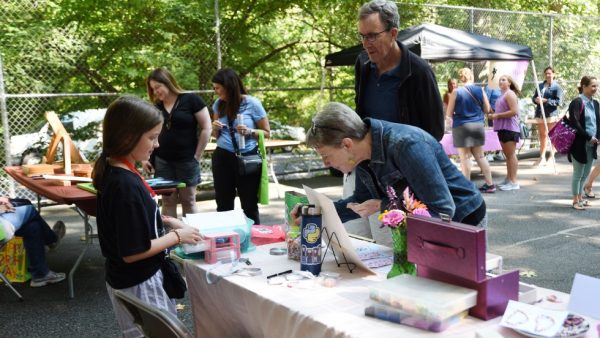
The kids’ art show features selected young artists as well as make & take art projects for children. Photo credit: Shannon Fretz, 2023.
Bruce Johnson and Reed Dixon continued to run the show for the next few years, taking turns creating the annual poster and using their advertising expertise to share the show with other artists. As professional artists themselves, Johnson and Reed also continued to display their own work while running the show, “My space was where the music was, right in the middle of the show. In case any problems came up, I wanted to be easy to find,” says Johnson.
Alongside their crew of volunteers, they expanded the show each year, adding in many of the elements that are seen today such as the kids’ art show, the emerging artists section, and live music. For refreshments though, their offerings were a far cry from the gourmet food court that the show boasts today, “At the original art shows, a family who lived in Gretna and owned Burger Kings and Pizza Huts would take over the firehouse and garage to serve hamburgers and hotdogs,” says Johnson.
But though the food may have taken a few years to improve, the show itself grew quickly from a hundred artists that first year to over two hundred in the years that followed. While they kept to a strict 50/50 split, “Reed and I were both painters—2-D artists—it was our rule that the art show would be 50% 2D and 50% 3D,” Johnson and Dixon focused heavily on enhancing the artists’ experience, “We tried to do all we could to make the artists feel good,” says Johnson, “including selling their work, because if you’re an artist at a show and you’re not selling, you’re not coming back.”
Johnson also credits much of the show’s growth to their word-of-mouth marketing, “If 100 artists are all doing shows, that’s where they’re going to talk to each other—‘oh that show was awful’ or ‘oh that show in Gretna, it’s the middle of nowhere, but you should see it’—so we promoted to artists, because without artists you don’t have an art show.” Further, both Johnson and Dixon were working as art directors at Armstrong Worldwide Industries at the time, which Johnson says gave them valuable resources and expertise in media and advertising.
“Other people began making it what it is today”
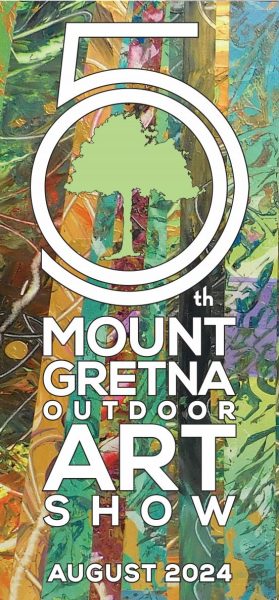
The 2024 art show poster was designed by Reed Dixon.
After running the show those first few years, Johnson and Dixon eventually handed the baton to Karl Gettle, who would serve as the director for 15 years. Following Gettle was Linda Bell, who served at the helm for 20 years, before the show’s current director, Kerry Royer, took the reins. In looking at the years that followed after he stepped down, Johnson credits these three directors with the show’s continued success, “We ran the show maybe four or five times… then other people began making it what it is today,” he says.
While no longer the director, Johnson continued to exhibit his professional work at the art show for many years. More recently, he was commissioned to create the poster for the 46th show in 2020, and over the years, t-shirts, posters, and even puzzles have been printed with his work for the Mount Gretna Outdoor Art Show.
Prior to this year’s art show, Johnson will be featured in a dialogue about the history of the art show during the PA Chautauqua’s Summer Art Lecture on Wednesday, August 14, at 7 p.m. The lecture is open to the public and will take place at the Hall of Philosophy, 212 Gettysburg Ave, Mt Gretna, PA 17064.
Learn more about the art show here!
About Bruce Johnson
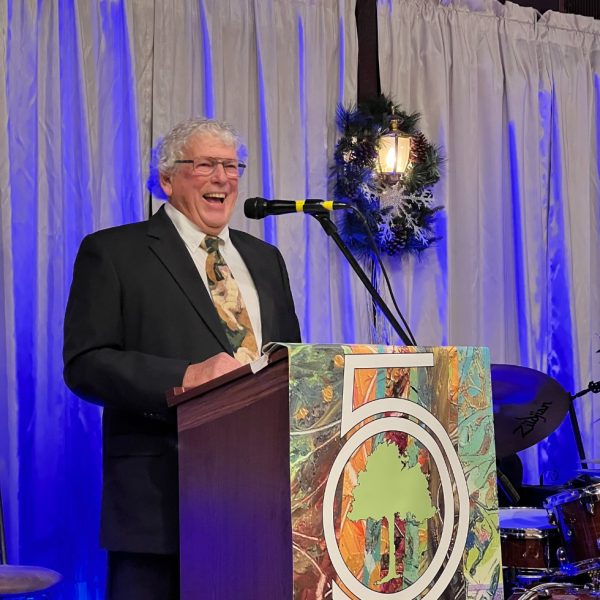
Bruce Johnson at the Art show Gala, January 2024.
Bruce Johnson was born in 1944 in Allentown, PA. After earning a Bachelor of Fine Arts from the Philadelphia College of Art, he served for three years as an Army illustrator in Europe, earning the Army Commendation Medal for his work with NATO. Johnson later became the art director at Armstrong World Industries, and he received multiple design awards in that role. Eventually, Johnson left advertising and began a successful career as a professional artist. Known for his whimsical pen and ink drawings and a member of the American Watercolor Society, Johnson’s work has been featured in countless art shows, including 64 solo shows, and he has been commissioned by many major corporations, such as the Hershey Trust Company, Boy Scouts of America, and General Electric. (bjohnsonltd.com)
Special thanks to Bruce & Donna Johnson for sharing their time, stories, and sharp memories with us!
By Darby Seymour, Public Relations Manager, Visit Lebanon Valley
![]()

